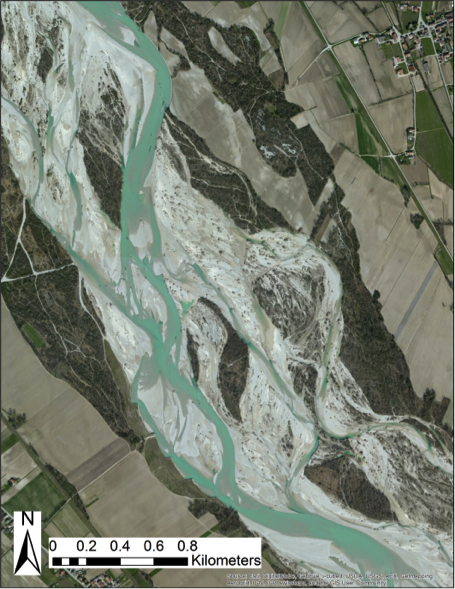Floods and Droughts Impact Ecosystems
How do floods and droughts impact ecosystems?
Variation in river flow (i.e., the river flow regime – see Module 3) exerts a strong influence on river and riparian ecosystem function. In particular, floods and droughts control the creation and maintenance of river and floodplain habitats and the sustainability of the high biodiversity observed along river systems. The temporal pattern of floods interacts with channel and floodplain topography to create a highly heterogeneous landscape of depressions, oxbows, gravel bars, and terraces (Figure 13). The hydro-geomorphic diversity means that the inundation frequency varies strongly over short distances on river floodplains, and creates habitats for a diverse suite of organisms adapted to a wide range of flooding frequencies.

Both riparian and aquatic organisms have adapted to take advantage of flood-drought cycles in river ecosystems. For example, many fish species time spawning runs to coincide with predictable floods, because this allows large adult fish to access small streams that provide optimal habitat for egg development and growth and survival of young fish. In the Amazon River, many fish species can almost be considered forest-dwelling fish, because they feed directly on leaves, fruits, seeds, and insects that fall into the river when it floods surrounding forests during the annual rainy season. Trees of these seasonally flooded forests have in turn developed fruits and seeds that mature during the flooding season and that can survive fish digestive systems in order to take advantage of the seed dispersal ability of mobile fish species. In the western U.S., cottonwood trees time the release of seeds to coincide with the recession of flood peaks in order to access fresh sediment deposits with elevated water tables that provide ideal habitats for germination.
It may be less obvious that droughts could be beneficial for aquatic and riparian biota, but when coupled with periodic flooding, droughts play an important role in the survival of many river organisms. During droughts, resources such as organic material and nutrients can accumulate on floodplain surfaces, and when a flood does occur there is a pulse of greater resource availability than would occur under regular flooding, and this period of high resource availability can ensure the quick growth and survival of organisms, including young fish. In addition, periodic drying of rivers and floodplain wetlands eliminates competitors and predators for organisms that can quickly colonize areas when water returns. Such areas of refuge from predators are critical for the persistence of many aquatic organisms and would not exist without periods of drought.
The importance of floods and droughts to the integrity of river-floodplain ecosystems is apparent when alterations to the natural flow regime occur. Riverine organisms are often closely adapted to the local magnitude, frequency, duration, and predictability of extreme events, such that alteration of any one component can threaten species persistence. For example, recruitment of cottonwood trees along many dammed rivers in the western U.S. has essentially ceased, because the dams prevent flooding and creation of germination sites during the spring when cottonwood trees release their seeds. Excessive drought is also highly detrimental to river systems. One of the most famous examples of drought impacts is seen in the Colorado River delta in Mexico, which was once a highly productive floodplain forest and swamp, but due to prolonged drought conditions in the river basin and water infrastructure development, is now a dry desert.
